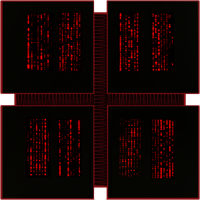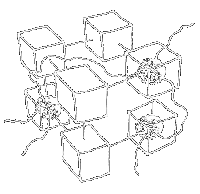Tamiko Thiel:
The Connection Machine
o Main Page
o CM Legacy: Technology
o CM-1/CM-2 Design Legacy
o Articles
o Image Galleries
o "Feynman"
CM-1 T-shirt
[ Email
]
[ Portfolio
]
 |
Connection Machine CM-1/CM-2 Design Legacy |
 |
The form of the Connection Machine CM-1/CM-2 (1986/1987) was explicitely designed to convey its radical, massively parallel computer architecture. At the time, parallel computing was considered at best impractical and at worst simply impossible. Danny Hillis however was convinced that, as in the human brain, a very large number of very small processors, each able to work on its own data and communicate quickly with the other processors, could enable computers to attack problems intractable for even the most powerful serial processors.
As the head of packaging design at Thinking Machines I wanted us to be able to say to customers, "You've never seen a machine like this in your life!" It should look like a living, thinking machine, "a machine that could be proud of us," as Danny delighted in saying.
The machine had to look stunning - and yet the form should also communicate the internal structure of the machine: over 64,000 tiny 1-bit processors connected into a 12-dimensional hypercube internal network (proposed by our moonlighting Nobel physicist Richard Feynman), and how these connections could change independently of the hardware structure to form data structures that best fit the problem at hand.
The final form of the machine reflected the logo I designed for the "Feynman" CM-1 t-shirt, expressing the hypercube network as a rigid cube-of-cubes, and the processors as soft "pom-poms" with malleable data structure connections independent of the hardware network. Read the full story in my essay "The Design of the Connection Machine," published in 1994 in the design theory journal DesignIssues, and in 2010 in the book "The Designed World," for an account of the images, artworks and architects that inspired the design. |
"Feynman" CM-1 t-shirt logo:
|
12-dimensional cube-of-cubes:
|
Joanna Hoffman, April 2017: How the Connection Machine inspired Steve Jobs
As aptly portrayed by Kate Winslet in the film "Steve Jobs," Joanna was marketing manager on the first Apple Macintosh, and on Steve Jobs' NeXT computer. In this interview, Joanna talks about his sense of design, and how he asked her to get the Connection Machine designer to create his NeXT computer as well - to which she replied, "Too late, Tamiko's gone to Europe to be an artist!" Jobs then hired Harmut Esslinger of Frog Design, and produced the NeXT computer as a perfect, matt black cube that marked a radical visual departure from his more prosaic designs for his previous Apple products.
Katharine Schwab interviewed me on this topic for Fast Company - and Paola Antonelli, the curator who acquired the machine for MoMA, tweeted it as well.
Total interview is 4:50 minutes. For subtitles click on icon lower middle-right.
View video on YouTube for additional background information and links on topics and people mentioned in the video.
Allen Hawthorne and Gordon Bruce, June 2017: Industrial Design of the CM-1/CM-2
In February 1984 we asked Allen Hawthorne and Gordon Bruce, then principal designers of Eliot Noyes Industrial Design after Mr. Noyes' demise, to do the industrial design of the CM-1/CM-2. (The firm was dissolved at the end of the year, and Al and Gordon continued on with us as independent contractors.) In these interviews they talk about their first impressions of the old Robert Treat Paine Mansion where Thinking Machines had its first HQ and the Connection Machine concept that we described to them. In further videos we discuss the design process, explorations and philosophy that led to the final form of the machine. See also the preliminary design sketches in the Image Gallery for details and sketches that are discussed in the videos.
As Senior Associate at Eliot Noyes, Al had experience designing futuristic scenarios: he had done preliminary concepts for Stanley Kubrick's film "2001: A Space Odyssey." This experience then led NASA to hire the Eliot Noyes firm to design the interiors for the actual Skylab Space Station, on which both Al and Gordon then worked. In the 1990s, Gordon went on (with James Miho) to completely revamp Samsung's design department, turning the company into the leading force in contemporary design that they are now.
Total interview playlist time is ~40 minutes. See links in texts above for images relating to discussions in the videos.
View videos on YouTube for additional background information and links.
Conversations on the Visual Design of the Connection Machines CM-1/CM-2
The following playlist is a series of very impromptu conversations between Brewster Kahle and myself on what the CM-1/CM-2 design meant to us, and Brewster's spontaneous interviews of me on my own experiences as product designer at Thinking Machines working on the machine.
For completion as a playlist on YouTube, it ends with two videos that appear elsewhere - Lew Tucker speaking on how the Connection Machine inspired the scientists and engineers who worked with the machine, and finally Joanna Hoffman's interview above.
Total interview playlist time is ~50 minutes divided over 6 videos.
View videos on YouTube for additional background information and links on topics and people mentioned in the videos.

